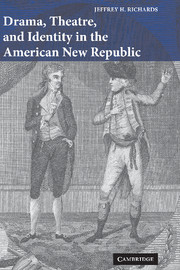Book contents
- Frontmatter
- Contents
- Acknowledgements
- Introduction
- 1 American identities and the transatlantic stage
- PART I Staging revolution at the margins of celebration
- PART II Coloring identities: race, religion, and the exotic
- 7 Susanna Rowson and the dramatized Muslim
- 8 James Nelson Barker and the stage American Native
- 9 American stage Irish in the early republic
- 10 Black theatre, white theatre, and the stage African
- PART III Theatre, culture, and reflected identity
- Notes
- Bibliography
- Index
9 - American stage Irish in the early republic
Published online by Cambridge University Press: 22 September 2009
- Frontmatter
- Contents
- Acknowledgements
- Introduction
- 1 American identities and the transatlantic stage
- PART I Staging revolution at the margins of celebration
- PART II Coloring identities: race, religion, and the exotic
- 7 Susanna Rowson and the dramatized Muslim
- 8 James Nelson Barker and the stage American Native
- 9 American stage Irish in the early republic
- 10 Black theatre, white theatre, and the stage African
- PART III Theatre, culture, and reflected identity
- Notes
- Bibliography
- Index
Summary
If at least partly inhabited by stage north africans and stage Natives, the early national American stage, like the late eighteenth-century London theatre, was home to Irish characters of all sorts. A few American playwrights before 1825 created Irish characters for their dramas, the subject of this chapter, but as with other ethnic types, the vast majority of plays featuring stage Irish figures were British (in the sense that they appeared in London before Philadelphia). Until the vogue for Irish stereotypes took control of the stage in the 1830s and 1840s, American playwrights were more likely to evoke other types first, notably the Yankee and the stage African, although in the English theatre, the man or woman of Ireland had been the comic foreigner of choice for a century. By the mid-nineteenth century, home-grown Irish types proliferated in the American theatre and would continue in the playhouse and on the cinema screen for the next hundred years. With Dion Boucicault, Irish comic characters on the American stage earned some measure of cultural stature and favorable critical commentary. Very little, though, has been said about the figuration of Irish types in American drama before the 1820s. Even so, American playwrights in the early republic did employ Irish characters, and a few turned to the image of the brogue-speaking, moderately foolish type that was later absorbed into the more outrageous and coarsely delineated Paddy.
- Type
- Chapter
- Information
- Drama, Theatre, and Identity in the American New Republic , pp. 188 - 210Publisher: Cambridge University PressPrint publication year: 2005



